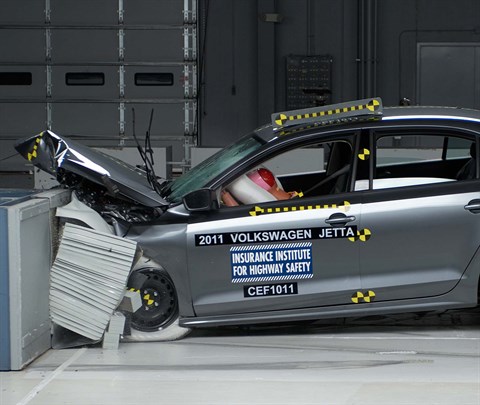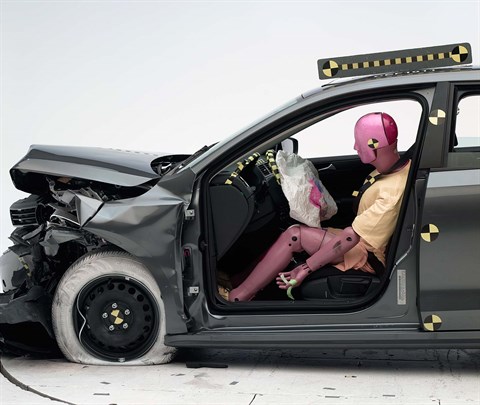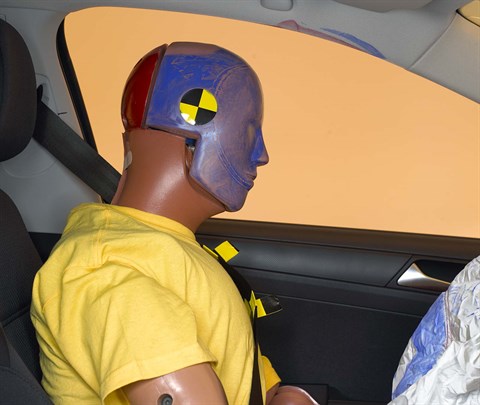Small overlap front: driver-side
Rating applies to 2013-14 models built after October 2012
Tested vehicle: 2012 Volkswagen Jetta S 4-door
The Volkswagen Jetta sedan was redesigned for the 2011 model year. Beginning with 2013 models built after October 2012, the side curtain airbags were reprogrammed to deploy in small overlap frontal crashes to improve occupant protection. (Information about when a specific vehicle was manufactured is on the certification label typically affixed to the car on the driver door or adjacent B-pillar.) The tested 2012 model car was retrofitted by Volkswagen engineers with a new airbag computer identical to that used in the modified production cars.
Note: The ratings do not apply to the station wagon version of the Jetta, known as the Jetta SportWagen, which is built on a platform designed earlier.
| Evaluation criteria | Rating |
|---|---|
| Structure and safety cage | |
| Driver injury measures | |
| Head/neck | |
| Chest | |
| Hip/thigh | |
| Lower leg/foot | |
| Driver restraints and dummy kinematics The dummy’s head barely contacted the frontal airbag before sliding off the left side as the steering column moved 14 cm to the right, leaving the head vulnerable to contact with forward structure. The frontal airbag module also detached from the steering column, which didn't appear to affect the dummy's movement because it occurred relatively late in the crash. Still, such detachments shouldn't occur. The side curtain airbag deployed and had sufficient forward coverage to protect the head from contact with side structure and outside objects. |
|

Action shot taken during the small overlap frontal crash test.

The dummy's position in relation to the door frame, steering wheel, and instrument panel after the crash test indicates that the driver's survival space was not maintained well.

During the crash, the dummy's head barely contacted the frontal airbag before sliding off to the left as the steering column moved to the right. The frontal airbag module detached from the steering column before the crash was finished.

The door hinge pillar and left footrest was pushed back by the wheel and tire (visible at lower left), and this intrusion contributed to a high risk of injury to the left lower leg.
Measures of occupant compartment intrusion on driver side
| Evaluation criteria | Measurement |
|---|---|
| Test ID | CEN1233 |
| Lower occupant compartment | |
| Lower hinge pillar max (cm) | 27 |
| Footrest (cm) | 19 |
| Left toepan (cm) | 9 |
| Brake pedal (cm) | 4 |
| Parking brake (cm) | |
| Rocker panel lateral average (cm) | 11 |
| Upper occupant compartment | |
| Steering column | 6 |
| Upper hinge pillar max (cm) | 8 |
| Upper dash (cm) | 15 |
| Lower instrument panel (cm) | 18 |
Driver injury measures
| Evaluation criteria | Measurement |
|---|---|
| Test ID | CEN1233 |
| Head | |
| HIC-15 | 191 |
| Peak gs at hard contact | no contact |
| Neck | |
| Tension (kN) | 1.8 |
| Extension bending moment (Nm) | 16 |
| Maximum Nij | 0.28 |
| Chest maximum compression (mm) | 27 |
| Femur (kN) | |
| Left | 2.3 |
| Right | 1.1 |
| Knee displacement (mm) | |
| Left | 0 |
| Right | 1 |
| Knee-thigh-hip injury risk (%) | |
| Left | 0 |
| Right | 0 |
| Maximum tibia index | |
| Left | 1.32 |
| Right | 0.42 |
| Tibia axial force (kN) | |
| Left | 6.6 |
| Right | 2.3 |
| Foot acceleration (g) | |
| Left | 276 |
| Right | 80 |
Moderate overlap front: original test
Rating applies to 2011-18 models
Tested vehicle: 2011 Volkswagen Jetta S 4-door
The Volkswagen Jetta sedan was redesigned for the 2011 model year. Two moderate overlap frontal tests of the Jetta were conducted, one by the Institute and the other by Volkswagen. Ratings are based on both tests.
These ratings do not apply to the station wagon version of the Jetta, known as the Jetta SportWagen, which is built on a platform designed earlier.
| Evaluation criteria | Rating |
|---|---|
| Overall evaluation | |
| Structure and safety cage | |
| Driver injury measures | |
| Head/neck | |
| Chest | |
| Leg/foot, left | |
| Leg/foot, right | |
| Driver restraints and dummy kinematics | |

Action shot taken during the Institute's moderate overlap frontal crash test.

The dummy's position in relation to the steering wheel and instrument panel after the crash test indicates that the driver's survival space was maintained well (Institute test car shown).

Smeared greasepaint indicates where the dummy's head hit the roof rail in the Institute's test.

Intrusion into the driver's space was minimal in both tests, and all leg and foot injury measures were low.
Measures of occupant compartment intrusion on driver side
| Evaluation criteria | Measurement | |
|---|---|---|
| Test ID | VTF1006 | CEF1011 |
| Footwell intrusion | ||
| Footrest (cm) | 4 | 8 |
| Left (cm) | 9 | 11 |
| Center (cm) | 6 | 8 |
| Right (cm) | 5 | 5 |
| Brake pedal (cm) | 8 | 4 |
| Instrument panel rearward movement | ||
| Left (cm) | 1 | 2 |
| Right (cm) | 2 | 1 |
| Steering column movement | ||
| Upward (cm) | -3 | 0 |
| Rearward (cm) | -5 | -1 |
| A-pillar rearward movement (cm) | 0 | 1 |
Driver injury measures
| Evaluation criteria | Measurement | |
|---|---|---|
| Test ID | VTF1006 | CEF1011 |
| Head | ||
| HIC-15 | 173 | 250 |
| Peak gs at hard contact | no contact | 53 |
| Neck | ||
| Tension (kN) | 1.6 | 1.2 |
| Extension bending moment (Nm) | 25 | 21 |
| Maximum Nij | 0.31 | 0.50 |
| Chest maximum compression (mm) | 33 | 33 |
| Legs | ||
| Femur force - left (kN) | 0.8 | 3.7 |
| Femur force - right (kN) | 1.5 | 1.7 |
| Knee displacement - left (mm) | 0 | 6 |
| Knee displacement - right (mm) | 2 | 11 |
| Maximum tibia index - left | 0.28 | 0.40 |
| Maximum tibia index - right | 0.49 | 0.76 |
| Tibia axial force - left (kN) | 2.0 | 1.7 |
| Tibia axial force - right (kN) | 3.3 | 1.6 |
| Foot acceleration (g) | ||
| Left | 72 | 100 |
| Right | 124 | 123 |
Side: original test
Rating applies to 2011-18 models
Tested vehicle: 2011 Volkswagen Jetta TDI 4-door with standard front and rear head curtain airbags and standard front seat-mounted torso airbags
The Volkswagen Jetta sedan was redesigned for the 2011 model year. Side ratings are assigned by the Institute based on a test conducted by Volkswagen.
Note: The ratings do not apply to the station wagon version of the Jetta, known as the Jetta SportWagen, which is built on a platform designed earlier.
| Evaluation criteria | Rating |
|---|---|
| Overall evaluation | |
| Structure and safety cage | |
| Driver injury measures | |
| Head/neck | |
| Torso | |
| Pelvis/leg | |
| Driver head protection | |
| Rear passenger injury measures | |
| Head/neck | |
| Torso | |
| Pelvis/leg | |
| Rear passenger head protection | |
Measures of occupant compartment intrusion on driver side
| Test ID | VTS1004 |
|---|---|
| B-pillar to longitudinal centerline of driver's seat (cm) | -13.0 |
| Negative numbers indicate the amount by which the crush stopped short of the seat centerline. | |
Driver injury measures
| Evaluation criteria | Measurement |
|---|---|
| Test ID | VTS1004 |
| Head HIC-15 | 97 |
| Neck | |
| Tension (kN) | 0.8 |
| Compression (kN) | 0.2 |
| Shoulder | |
| Lateral deflection (mm) | 43 |
| Lateral force (kN) | 1.5 |
| Torso | |
| Maximum deflection (mm) | 43 |
| Average deflection (mm) | 40 |
| Maximum deflection rate (m/s) | 4.94 |
| Maximum viscous criterion (m/s) | 0.98 |
| Pelvis | |
| Iliac force (kN) | 2.6 |
| Acetabulum force (kN) | 2.5 |
| Combined force (kN) | 4.9 |
| Left femur | |
| L-M force (kN) | 0.8 |
| L-M moment (Nm) | 31 |
| A-P moment (Nm) | 149 |
Passenger injury measures
| Evaluation criteria | Measurement |
|---|---|
| Test ID | VTS1004 |
| Head HIC-15 | 313 |
| Neck | |
| Tension (kN) | 0.3 |
| Compression (kN) | 0.6 |
| Shoulder | |
| Lateral deflection (mm) | 38 |
| Lateral force (kN) | 1.2 |
| Torso | |
| Maximum deflection (mm) | 42 |
| Average deflection (mm) | 40 |
| Maximum deflection rate (m/s) | 3.83 |
| Maximum viscous criterion (m/s) | 0.65 |
| Pelvis | |
| Iliac force (kN) | 0.7 |
| Acetabulum force (kN) | 2.2 |
| Combined force (kN) | 2.6 |
| Left femur | |
| L-M force (kN) | 0.3 |
| L-M moment (Nm) | 59 |
| A-P moment (Nm) | 57 |
Roof strength
Rating applies to 2011-18 models
Tested vehicle: 2011 Volkswagen Jetta S 4-door
| Overall evaluation | |
|---|---|
| Curb weight | 2,963 lbs |
| Peak force | 15,859 lbs |
| Strength-to-weight ratio | 5.35 |
Head restraints & seats
Seat type: Manual cloth seat
| Overall evaluation | |
|---|---|
| Dynamic rating | |
| Seat/head restraint geometry |
| Seat type | Manual cloth seat |
|---|---|
| Geometry | |
| Backset (mm) | 35 |
| Distance below top of head (mm) | 10 |
| Seat design parameters | |
| Pass/fail | Pass |
| Max T1 acceleration (g) | 13.0 |
| Head contact time (ms) | 53 |
| Force rating | 1 |
| Neck forces | |
| Max neck shear force (N) | 38 |
| Max neck tension (N) | 491 |
About the head restraint & seat test
Currently, IIHS tests apply only to front seats.
